



Antioxidant Effects of Oregano in Laying Hens
Report from Meriden Animal Health of a trial carried out in Egypt showing that one per cent oregano increased egg production by local hens as well as nutritional composition and antioxidant activity to protect the nutritional profile of the ingredients within the eggs.Orego-Stim has been used extensively for successful poultry production in broilers, layers and breeders. Previous trials have shown that Orego-Stim can be used to increase egg production. Orego-Stim has also been demonstrated to increase mean egg production from 68 per cent to 80 per cent over a one–month period. Orego-Stim gets pullets quicker to their maximum point of lay by increasing the rate of enterocyte cellular turnover in the gastrointestinal tract, improving nutrient absorption and egg production.
Field observations have shown that Orego-Stim produces uniform coloured eggs, with less blood spots and faeces. This is correlated to the significant decrease in the number of inferior or faulty eggs, reduction in the proportion of dirty eggs and better homogeneity egg weights, manifested by a higher number of top grade eggs. These measurements on morphology and physical presentation of eggs were made arbitrarily by the farm manager.
This latest trial outlined in this bulletin measured the physical and nutritional characteristics of eggs from laying hens at the Department of Poultry Nutrition, Animal Production Research Institute, Agriculture Research Centre at Giza, Egypt. Of particular interest in this trial was the natural herbal antioxidant protective function to delay lipid oxidation in eggs.
Commercial Use of Antioxidants
Conventional antioxidants used for animal feed such as Butylated Hydroxy Toluene (BHT) and Butylated Hydroxyl Anisole (BHA) are subject to maximum daily intakes in human and animal feeds but recently, cancer has restricted their use (Imaida et al., 1983; Okada et al., 1990). Eugenol, carvacrol and thymol are the major components present in oregano essential oils, and BHA has similar molar equivalent antioxidant capacities (Dorman et al., 2000).
The family of mint plants (Labiatae) comprises around 3,000 species. Certain oregano species have antioxidant properties between three and 20 times greater than any other herb studied. Per gram of fresh weight, one species member of this family of plants has 42 times more activity than apples, 30 times more than potatoes and 12 times more than oranges.
Orego-Stim contains essential oils from a member of the Labiatae family. Orego-Stim contains carvacrol and thymol, which are powerful bioflavonoid phenolic and antioxidant compounds counteracting the damaging effect of free radicals. As an effective antioxidant, Orego-Stim also protects unsaturated lipids, and vitamins A, D and E in animal feed.
The Trial
This trial examined the effects of natural antioxidants on the oxidation of eggs, egg production and reproductive performance of laying hens. A total number of 360 Al-Salaam hens and 36 Al-Salaam cocks at 28 weeks of age were randomly distributed into 12 groups with three replicates each (10 hens, one cock). Birds fed on experimental diets at two levels (0.5 and 1.0 per cent) from four types of herbs (oregano, thyme, rosemary, curcuma longa) and control diets with and without vitamin E for a period of 90 days. All diets were isonitrogenous (16 per cent CP) and isocaloric (2700kcal ME per kg diet).
Results
Addition of 1.0 per cent (thyme, rosemary or oregano) or 0.5 per cent Curcuma longa as natural antioxidants to laying hens diets increased egg mass, egg production and improved feed conversion. Addition of 1.0 per cent (oregano or rosemary) or 0.5 per cent curcuma longa during laying period decreased malonaldehyede formation in egg yolk and had positive effect on oxidative stability of shell eggs storage. Average egg shell weight and thickness were increased with 1.0 per cent oregano compared to the control. The 1.0 per cent oregano treatment reduced albumen weight and increased yolk weight by almost,two per cent, respectively, compared to the control.
Malondialdehyde is a biochemical marker of oxidative stress which can de-grade polyunsaturated lipids found in the yolk of eggs. The 1.0 per cent oregano treatment produced the least malondialdehyde in fresh eggs, and this low level was maintained over a 30 day storage period without significant further production increases compared to all other treatments. These positive effects of oxidation prevention stability were also recorded as significantly improving egg fertility by over 15 per cent over the same period.
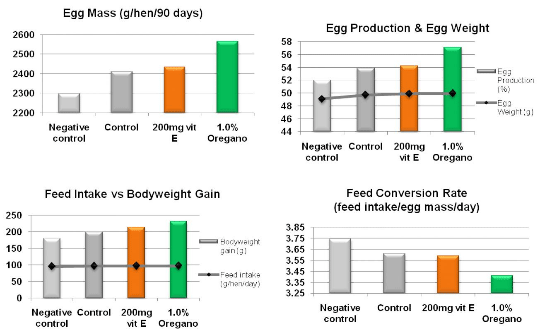
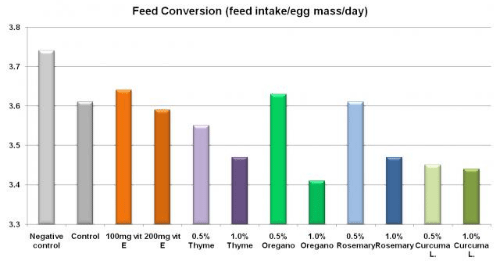

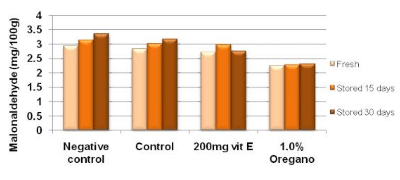
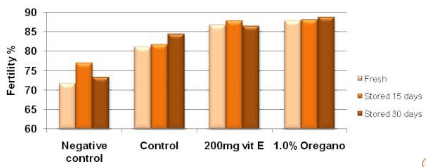
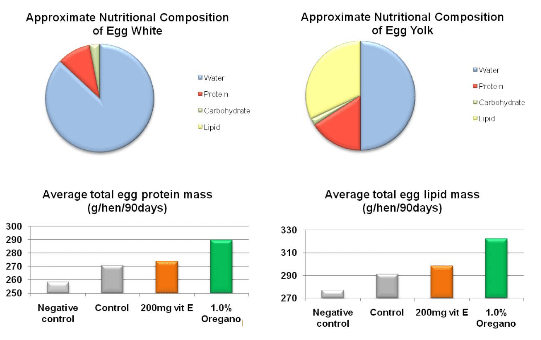
Discussion
This experiment was carried out at a specifically designated poultry nutrition research institute. From the start, it is important to note that the herbs used in this experiment cannot be effectively integrated into commercial poultry feeds. In order for herbs to be used as commercial feed additives, they must be processed into a concentrated form, which allows for pelleting in animal feed plants without loss of the key characteristics of the specific herbal compounds.
The key bioflavonoid compounds are phenolic in Nature found in the essential oils. Essential oils are hydrophobic aromatic compounds and can include a wide range of chemical ingredients such as alcohols, aldehydes, esters, ethers, ketones, phenols and terpenes. The compounds carvacrol and thymol are known antioxidant agents present in various concentrations in thyme and oregano essential oils. Meriden Animal Health Limited has developed a novel technique to preserve the unique natural characteristics of essential oils into a form which can be used in animal feeds with preservation of these special characteristics.
This trial provides further evidence of the performance characteristics of laying hens on egg quality and production parameters and provides numerical quantification of results previously quantified by field observations alone.
This is useful information that can also be applied to the nutritional composition of egg production. The nutritional composition of egg white is approximately 87 per cent water and 10 per cent protein. Egg yolks are approximately 50 per cent water, 16 per cent protein and 32 per cent lipid (Figures 10 and 11).
Using these nutritional specifications, it is possible to calculate how much protein and lipids were produced by the eggs based on the average egg mass produced per hen over 90 days, the percentage albumen or yolk weight. Figures 12 and 13 show the 1.0 per cent oregano group produced an average of 19g more protein and 32g more lipid per hen over the 90-day period. On a farm with 10,000 birds, this equates to a nutritional increase in production of an extra 190kg of protein and 320kg of lipid within the harvested eggs over a 90-day period! This extra production allows for superior graded eggs and extra profits for the producers.
Conclusion
This trial provides more evidence of the beneficial use of dietary herbal ingredients into laying hen diets. Orego-Stim captures these natural bioflavonoid essential oil based compounds as a commercial product with proven production increases in commercially produced laying hens around the world.
In this trial, the 1.0 per cent oregano treatment successfully increased production, nutritional composition and antioxidant activity to protect the nutritional profile of the ingredients within the eggs. Orego-Stim also provides these same benefits in either application as either an in-feed powder or a liquid into the drinking water of laying hens.
References
Dorman, H.J., P. Surai and S.G. Deans, 2000. In vitro antioxidant activity of a number of plant essential oils and phytoconstituents. J. Essent. Oil Res., 12:241-248.
Imaida, K., S. Fukishima, T. Shirai, M. Ohtami, K. Nakamish and N. Ito, 1983. Promoting activities of butylated hydroxyanisole and butylated hydroxytoluene on 2-stage urinary carcinogenesis and inhibition of gamma-glutamyl trans peptidepositive for development in the liver of rats. Carcinogenesis, 4:895-899
Okada, Y, H. Okajima, H. Konoshi, M. Terauchi, K. Ishii, I.M. Liu and H. Watanabe, 1990. Antioxidant effect of naturally occurring furan fatty acids on oxidation of linoleic acid in aqueous dispersion. J. Am. Oil Chem. Soc., 67:858-862
Radwan Nadia, L., R.A. Hassan, E.M. Qota and H.M. Fayek (2008) Effect of Natural Antioxidant on Oxidative Stability of Eggs and Productive and Reproductive Performance of Laying Hens. International Journal of Poultry Science 7(2):134-150








